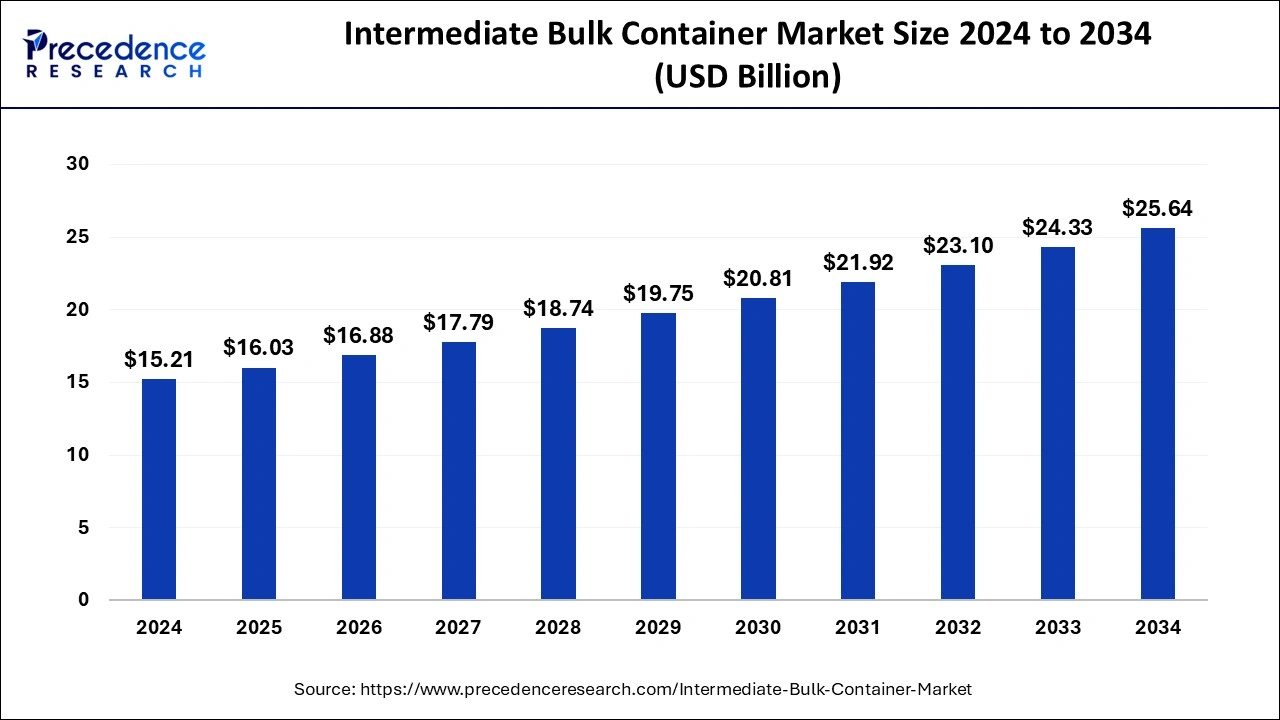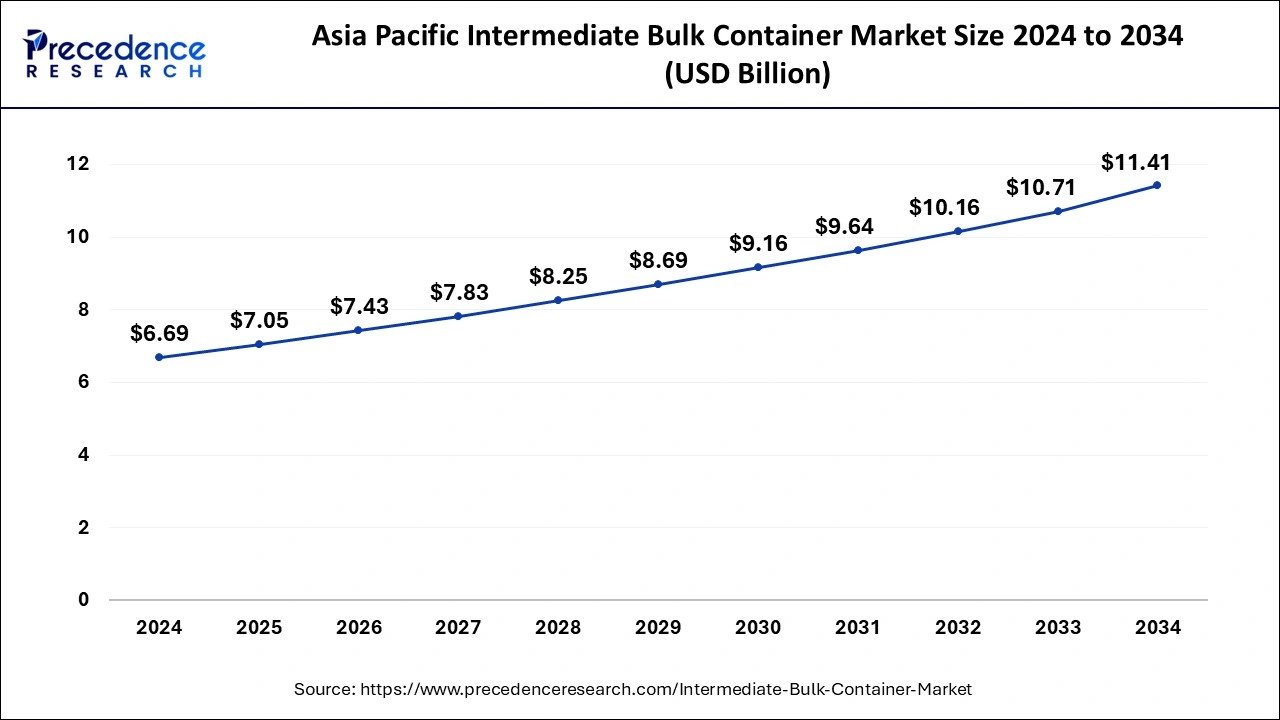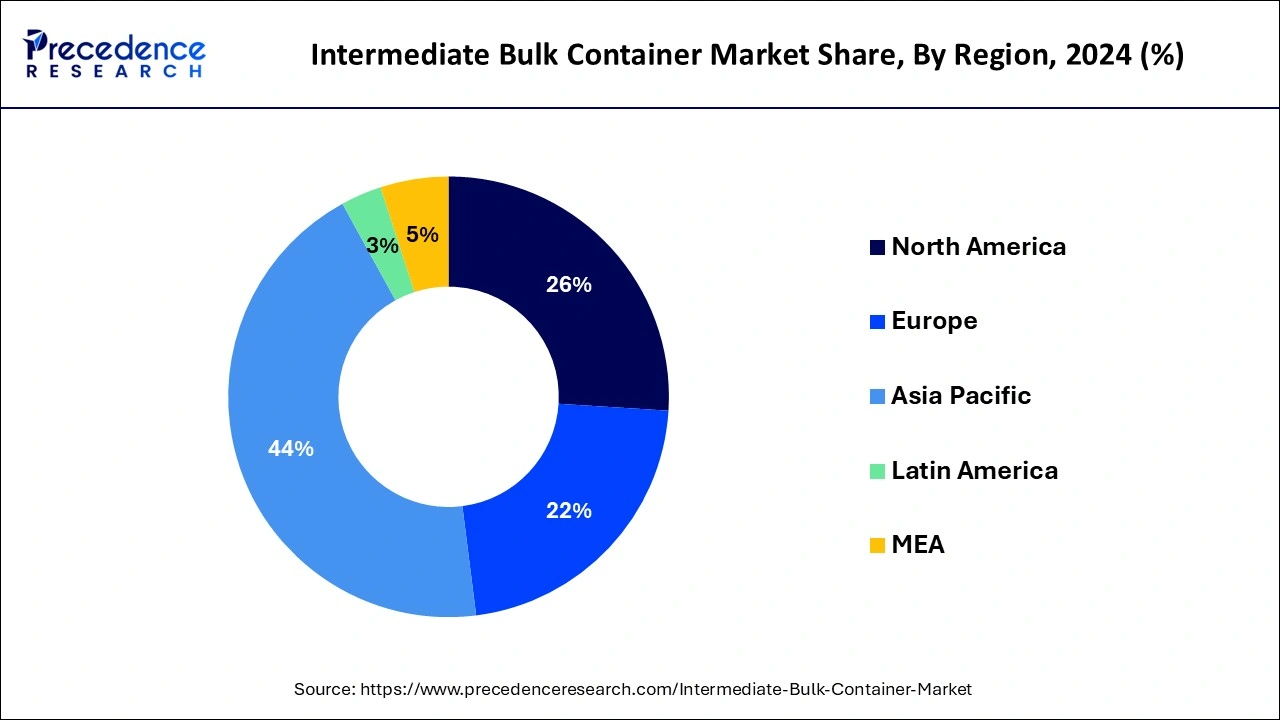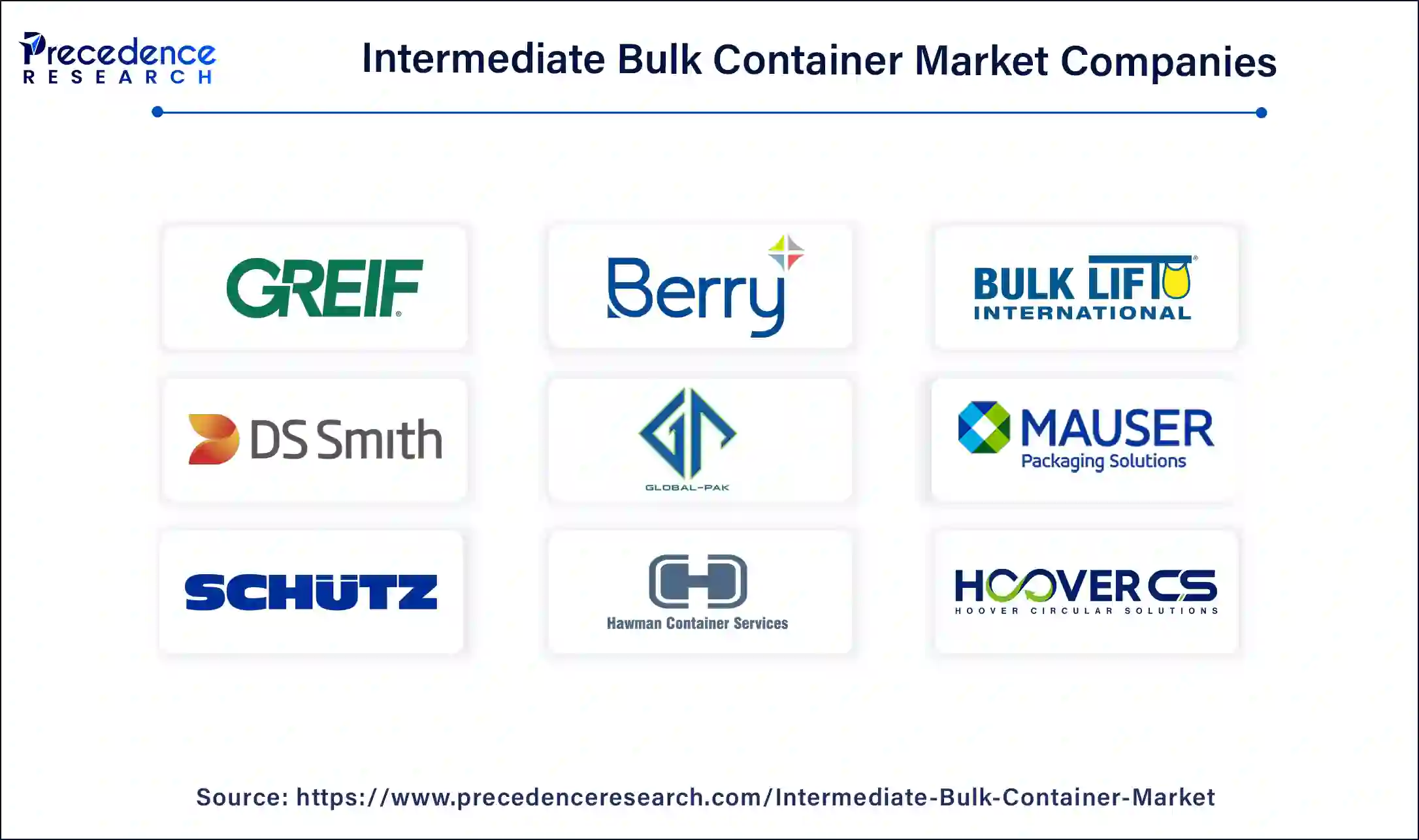The global intermediate bulk container market size is evaluated at USD 16.03 billion in 2025 and is forecasted to hit around USD 25.64 billion by 2034, growing at a CAGR of 5.36% from 2025 to 2034. The Asia Pacific market size was accounted at USD 6.69 billion in 2024 and is expanding at a CAGR of 5.48% during the forecast period. The market sizing and forecasts are revenue-based (USD Million/Billion), with 2024 as the base year.
The global intermediate bulk container market size accounted for USD 15.21 billion in 2024 and is expected to exceed USD 25.64 billion by 2034, growing at a CAGR of 5.36% from 2025 to 2034. The escalating demand for cost-effective and efficient storage and transportation of large quantities of goods is increasing the adoption of the intermediate bulk container market.

The integration of artificial intelligence in the intermediate bulk container market is expected to bring revolutionary changes, including automation, enhanced designs, and manufacturing processes, which will also improve precision and reduce wastage. Automation comprises advanced robotics and process control systems that will increase production efficiency and bring consistent quality. Implementation of artificial intelligence in IBC will support cost-saving, fulfill the customization demand, and offer high-quality packaging solutions.
The Asia Pacific military displays market size was evaluated at USD 6.69 billion in 2024 and is projected to be worth around USD 11.41 billion by 2034, growing at a CAGR of 5.48% from 2025 to 2034.

Asia Pacific dominated the global intermediate bulk container market in 2024. The dominance of this region is noted due to the rising industrial spending, which encourages the development of small and medium-scaled companies. The predominant growth is held by countries such as China, Japan, and India.
Asia Pacific has demonstrated a presentation initiating towards Sustainable Development Goals (SDGs), particularly in energy and industrial production. The region is making strategic industrial policy interventions, collaborating with stakeholders, and developing flexible and adaptable approaches towards national and regional platforms.

Europe is expected to expand at a solid CAGR in the intermediate bulk container market during the forecast period. The expansion of the region is credited to the healthcare and pharmaceutical industry growth in the region. The world’s 51% pharmaceutical product consumption is witnessed in Europe, which is domestically manufactured.
The largest producers of pharmaceutical foods requiring intermediate bulk containers are countries including Ireland, Germany, France, and Belgium. The pharmaceutical industry supports employment to about 2.3 million people within Europe for various departments in the EU27 economy and 2.8 million jobs in the European economy.
India
In September 2024, Shree Tirupati Balajee Agro Trading Company Limited- a leading manufacturer of Flexible Intermediate Bulk Containers (FIBCs) and other packaging products plans to raise INR 169.65 crore from its public issue. The minimum lot size for an application is 180 shares. The minimum amount of investment required by retail investors is INR 14,940.
Intermediate bulk containers, or IBCs, are containers used for storing and shipping goods in bulk quantities. The intermediate bulk containers may be used to ship and store bulk chemicals such as hazardous material or dangerous goods, components, powders, some liquids, food items, and rainwater for harvesting and live fish in an aquaponic gardening system. They are manufactured to meet industrial standards and are designed to contain liquids, semi-solids, pastes, or solids. Dispensable tools have emerged across various industries, including food, chemical, pharmaceuticals, agriculture, manufacturing, and construction, due to their versatility and adaptability.
| Report Coverage | Details |
| Market Size by 2024 | USD 15.21 Billion |
| Market Size in 2025 | USD 16.03 Billion |
| Market Size in 2034 | USD 25.64 Billion |
| Market Growth Rate from 2025 to 2034 | CAGR of 5.36% |
| Dominating Region | North America |
| Fastest Growing Region | Europe |
| Base Year | 2024 |
| Forecast Period | 2025 to 2034 |
| Segments Covered | Material, End-use, and Regions |
| Regions Covered | North America, Europe, Asia-Pacific, Latin America, and Middle East & Africa |
Efficient storage
The intermediate bulk containers are known to enhance storage efficiency through their stackable design, which ensures optimal use of the vertical space in the warehouse. This is also an advantage for businesses with limited storage space. An ideal storage space optimizes the space during transportation, which is a critical aspect of logistics and supply chain management. The uniform and square-shaped design credits to the improved storage space. This practice ultimately results in reduced transportation costs, fewer trips, and a lower carbon footprint. Businesses that are seeking to enhance their logistics while reducing environmental impact for IBCs as a better option.
Stringent regulation
A detailed regulation needs to be followed for the usage of intermediate bulk containers especially for storage and transportation purposes of hazardous material. If an intermediate bulk container market product is used non-compliant, it could result in penalty charges for the company. It also has strict rules for the construction of tanks, it should be made from compatible material and resist any deterioration. There must be UN-recognized markings on the containers. The company owner must have the federal and NSF/ANSI regulation certificate approved by IMDG for domestic and maritime transport.
Advancements in IBC technology
The growing demand for efficient packaging and shipping solutions is encouraging the growth of the intermediate bulk container market. The manufacturers are gradually investing in intermediate bulk containers to enhance the IBC technology. The aim is to make them more effective and adaptable for businesses and industries all across the world. The incorporation of cutting-edge innovation is expected to be witnessed to improve the packaging and transportation solution in the intermediate bulk containers sector. There is consistent research and development taken to refine the IBC technology and achieve the desired goal.
The plastic segment contributed the highest intermediate bulk container market share in 2024. The dominance of this segment is observed due to the popularity of plastic material in intermediate bulk containers as they are made from polyethylene or high-density polyethylene (HDPE). Additionally, they are more convenient and have low-cost characteristics. The durability and sealability protect the product from deterioration and increase its shelf life from 5 to 10 days.
The metal segment is expected to grow rapidly in the intermediate bulk container market over the forecast period. The intermediate bulk containers are commonly made of carbon steel or stainless steel, available in various capacities from 110 to 550 gallons. Metal alloy IBCs offer a durable, and reusable solution for packaging, transportation, and storage needs. An ideal metal intermediate bulk container must meet and exceed the UN/DOT regulations before being used in industries.
The chemical and petrochemical segment dominated the intermediate bulk container market in 2024. The chemical relies highly on intermediate bulk containers for the secure storage and transportation of hazardous and valuable products long distances without the risk of leakage. An intermediate bulk container is widely used in the chemical industry to manufacture plastic products such as plastic drums. The versatile, cost-effective, and convenient ability makes it highly adopted in the chemical and petrochemical industry.
The pharmaceuticals segment is expected to show the fastest growth in the intermediate bulk container market during the predicted timeframe. In pharmaceutical sectors intermediate bulk containers are used for transportation and storage of pharmaceutical products. Intermediate bulk containers are gaining traction as they safeguard drugs and other pharmaceutical products, preventing them from damage and contamination, and making sure of their safety, stability, and efficacy.

By Material
By End-Use
By Geography
For inquiries regarding discounts, bulk purchases, or customization requests, please contact us at sales@precedenceresearch.com
No cookie-cutter, only authentic analysis – take the 1st step to become a Precedence Research client